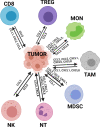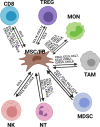Chemokine signaling in cancer-stroma communications
- PMID: 34086259
- PMCID: PMC8222467
- DOI: 10.1007/s12079-021-00621-7
Chemokine signaling in cancer-stroma communications
Abstract
Cancer is a multi-faceted disease in which spontaneous mutation(s) in a cell leads to the growth and development of a malignant new organ that if left undisturbed will grow in size and lead to eventual death of the organism. During this process, multiple cell types are continuously releasing signaling molecules into the microenvironment, which results in a tangled web of communication that both attracts new cell types into and reshapes the tumor microenvironment as a whole. One prominent class of molecules, chemokines, bind to specific receptors and trigger directional, chemotactic movement in the receiving cell. Chemokines and their receptors have been demonstrated to be expressed by almost all cell types in the tumor microenvironment, including epithelial, immune, mesenchymal, endothelial, and other stromal cells. This results in chemokines playing multifaceted roles in facilitating context-dependent intercellular communications. Recent research has started to shed light on these ligands and receptors in a cancer-specific context, including cell-type specificity and drug targetability. In this review, we summarize the latest research with regards to chemokines in facilitating communication between different cell types in the tumor microenvironment.
Keywords: Cancer; Chemokines; Review; Tumor microenvironment.
Conflict of interest statement
The authors have no conflicts of interest to declare.
Figures



References
Publication types
Grants and funding
LinkOut - more resources
Full Text Sources

